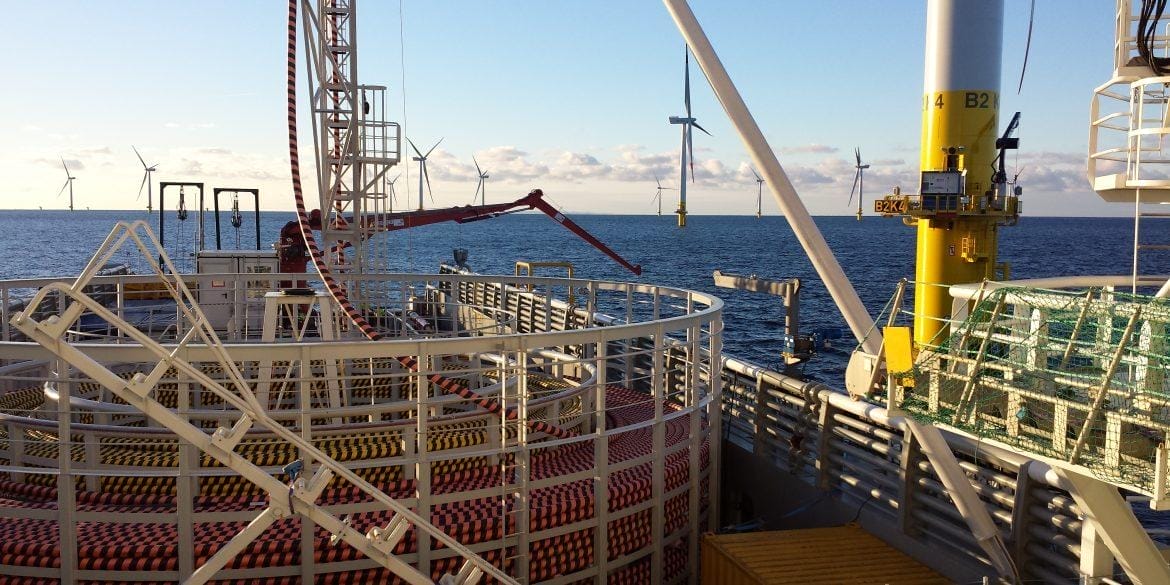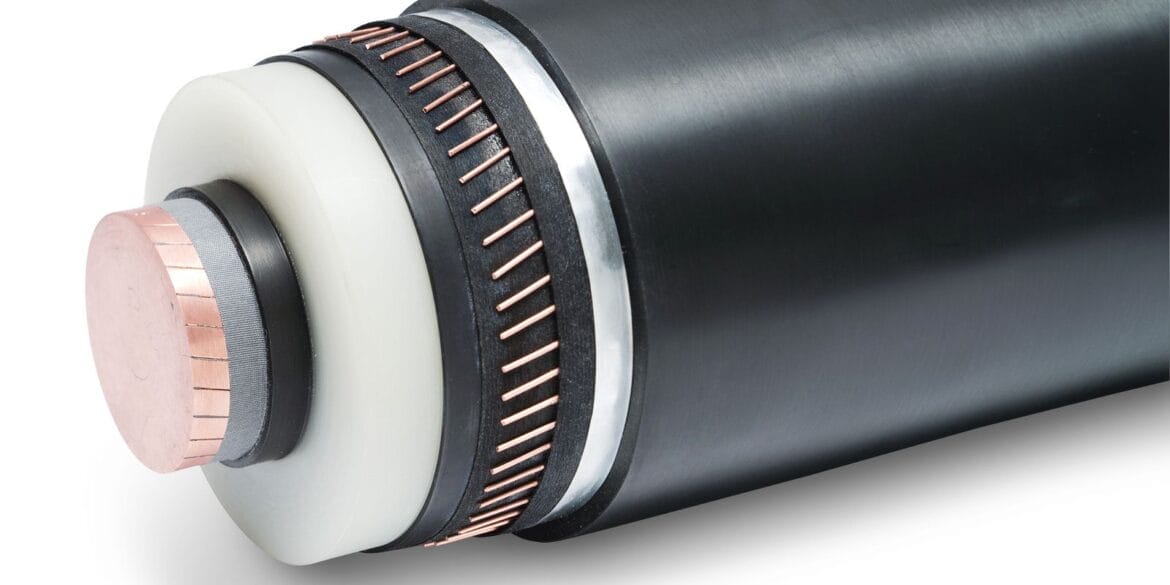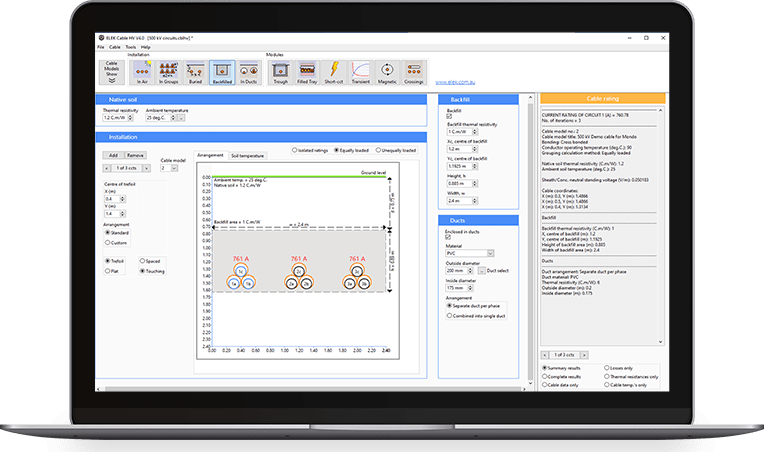Table of Contents
Introduction
Power cables are often installed on exposed metallic trays in industrial and commercial electrical systems, a widely accepted practice in these environments. The most common method of installing power cables in tunnels is mounting them on metal brackets or cable trays attached to the sides. Cable trays offer numerous advantages, including ease of installation, flexibility, and improved cable management. However, they also present challenges in terms of heat dissipation, which directly impacts the ampacity of the installed cables.
Cable ampacity, the maximum current-carrying capacity, is a critical factor in the design and operation of power cable systems. Cables installed in trays have lower ampacity than cables installed in free air or on cable ladder supports because the tray restricts airflow to the cables’ bottom and top (if covered). The cables in trays are typically installed in close groups or bundles, causing strong mutual heating effects. Metal trays also have electromagnetic effects that impact cable ampacities including increased cable conductor resistance caused by the flow of induced current in the metal tray and heat-generating eddy currents.
This article will explain the thermal and electromagnetic factors affecting cable ampacity in tray installations, discuss various calculation methods (analytical and numerical), summarise the standards including IEC 60287, and outline three different methods for calculating the ampacity of cables installed in trays.
How Trays Affect the Cable Ampacity
Cable trays reduce (derate) cable ampacity in three ways:
By altering heat transfer conditions (the most significant mechanism).
By increasing the resistance of the cable due to the proximity effect with a metal tray.
By induced losses due to eddy currents in a metal tray.
1. Altering heat transfer conditions
Metallic (and non-metallic) trays alter the heat transfer conditions for cables in several ways:
They act as a heat sink, potentially improving heat dissipation from the cables.
They can also restrict airflow around the cables, reducing convective cooling.
The tray thermal conductivity affects how efficiently heat is transferred away from the cables.
Tray geometry (e.g. open or closed trays) impacts air circulation and heat dissipation.
Because of the very strong mutual heating effects from the cables being in physically close proximity, grouping of the cables on the tray affects the heat transfer.
2. Increasing cable resistance due to proximity effect
The proximity effect refers to the phenomenon where the magnetic fields of adjacent conductors influence each other’s current distribution. In the context of cables in metallic trays:
-
The metallic tray acts as an additional conductor, influencing the magnetic fields around the cables.
-
This can cause current to flow non-uniformly in the cable conductors, concentrating towards the edges.
-
The non-uniform current distribution effectively increases the AC resistance of the conductors.
-
This effect increases at higher frequencies (harmonics) and with larger cable cross-sections.
The increased effective resistance leads to higher power losses and thus reduces the cable’s ampacity.
3. Induced losses due to eddy currents in the tray
Eddy currents are circular electric currents induced within conductors by a changing magnetic field. In the case of cables on magnetic metal such as galvanised steel tray:
The alternating currents in the cables produce changing magnetic fields.
These changing fields induce eddy currents in the metallic tray.
The eddy currents in the tray generate additional heat through Joule heating.
This additional heat contributes to the overall thermal environment of the cables.
The eddy currents induced in the metallic tray generate additional heat. Generally, these tray losses are very small compared to the losses in the conductors (even at high frequencies) for trays with typical magnetic permeability and conductivity values.
Problems can occur with magnetic metal tray heating when the phase sequence and configuration of power cables are not properly arranged. In general, three-phase power cable circuits arranged on a magnetic metal tray should be in either flat or trefoil configuration.
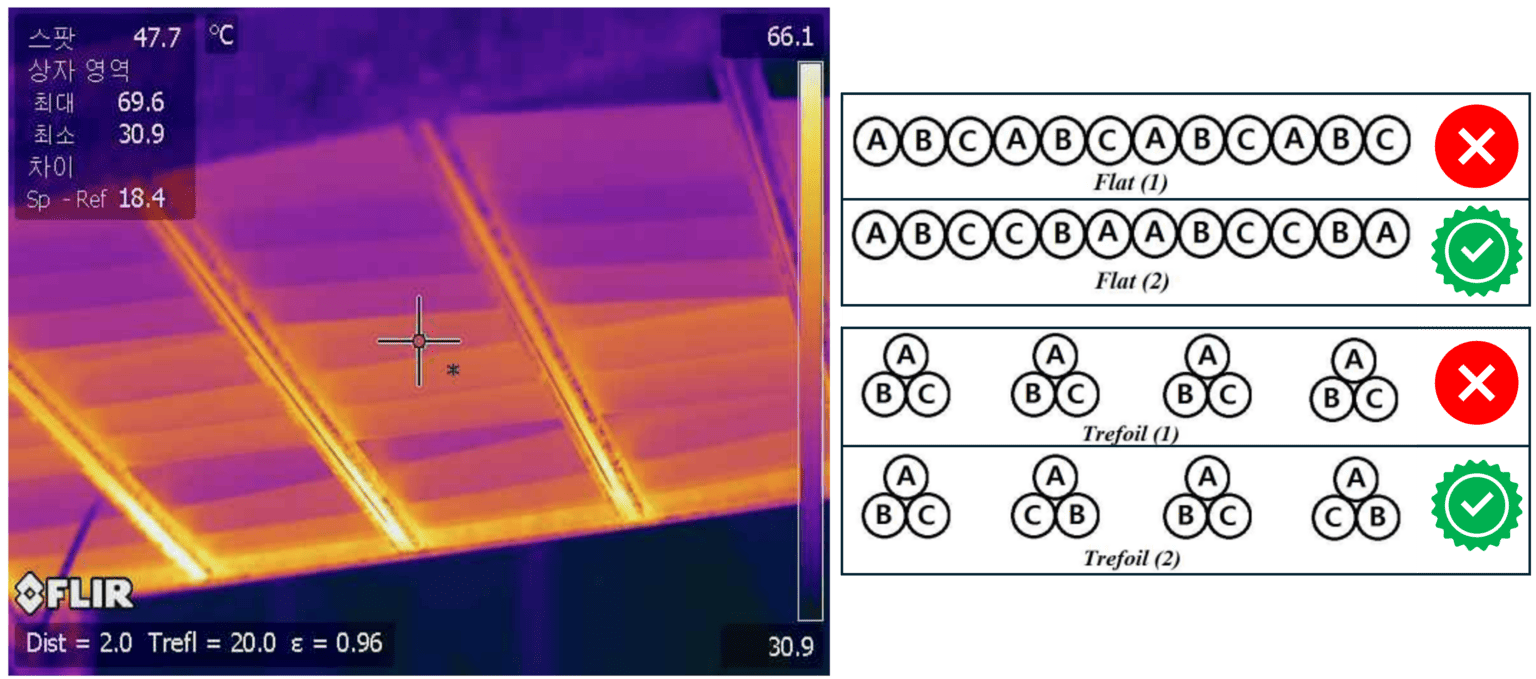
How to Calculate the Ampacity of Cables in Trays
The calculation of the current rating of cables installed in trays is complicated due (a) the restriction of the air flow around the cables; and (b) the mutual heating between closely spaced, touching, or bundled cables. For cable tray installations, there are three methodologies of calculating the ampacity of cables.
The first method is to use IEC 60287 in air or in groups in air rating calculations and to combine (multiply) with derating factors taken from tables in various low- and medium-voltage international standards. ELEK Cable High Voltage Software can be used for these calculations.
The second calculation method utilises a thermal/electrical equivalent circuit model and the third uses finite element analysis.
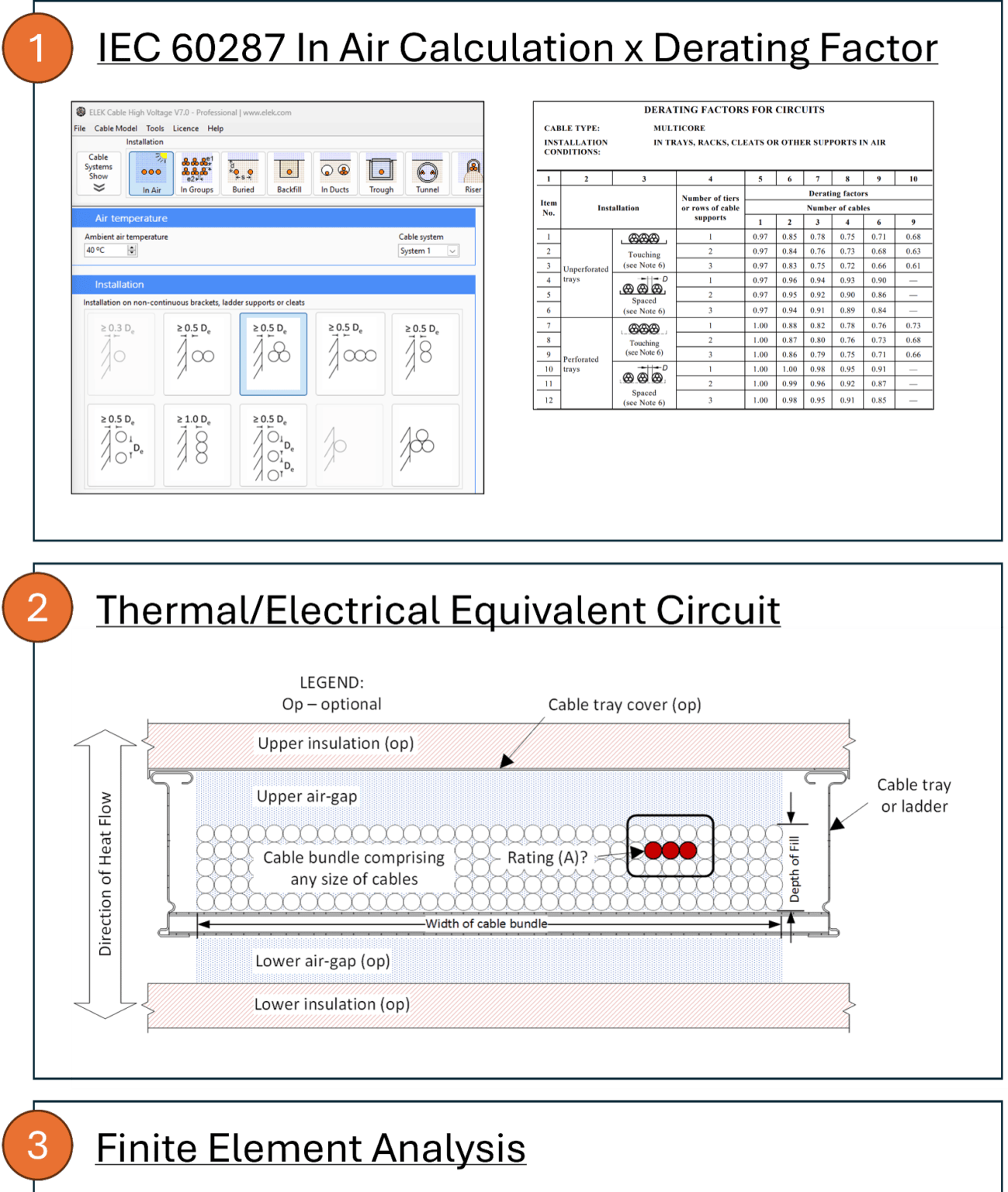
The advantages and disadvantages of the calculation methods are outlined in the table.
| Methodology | Advantages | Disadvantages |
|---|---|---|
| IEC 60287 In Air or In Groups calculation with Derating Factors from standards | Good method to use when there are only a few cables side-by-side in uncovered trays. | Not suitable for bundled cables or heavily-filled trays. There are only approximate derating factors accounting for tray covering [3]. |
Thermal and Electrical Equivalent Circuit
 Filled Cable Trays module
Filled Cable Trays module
|
Analytical equations. Can deal with open and covered cable tray. Can account for diversity of cable (bundle) loading. High accuracy - good agreement with FEA results [5]. | Limited up to 35 kV cables [3,5]. The model is complicated and requires experimental and FEA validation. Requires a software or math tool implementation. |
| Finite Element Analysis (FEA) | Provides the highest accuracy. | Difficult model setup - requires expert FEA skills. Bonding is very difficult to account for in the model. Long computation times. |
Summary of Standards
The following tables lists standards providing guidance on the ampacity of cables installed in trays.
| Standard | Advantages |
|---|---|
| IEC 60287 [1] |
|
| ICEA/NEMA P54-440 [3] |
|
| NEC |
|
| AS/NZS 3008.1 |
|
| BS 7671 |
|
| IEC 60364-5-52 |
|
| Additional guidance for covered trays and tray surface emissivity |
|
Recommendations
Cable arrangement: Properly arrange three-phase power cable circuits on metallic trays in either flat or trefoil configuration to minimise magnetic field interactions and reduce tray heating.
Tray material and surface: Consider using non-metallic trays or trays with low magnetic permeability to reduce proximity effects and eddy current losses. For metallic trays, paint them with a matte colour to increase surface emissivity, which can improve ampacity by up to 6% for uncovered trays and 30% for covered trays.
Ventilation: Opt for ventilated or perforated trays over solid bottom trays to improve air circulation and heat dissipation. If solid bottom trays are necessary, ensure proper engineering supervision.
Cable spacing: When possible, maintain spacing between cables to reduce mutual heating effects. For heavily filled trays, consider using the thermal/electrical equivalent circuit method or finite element analysis for more accurate ampacity calculations.
Derating factors: Apply appropriate derating factors based on the number of conductors, ambient temperature, and tray cover status. For covered trays, expect ampacities to be approximately 70-75% of open tray values.
Calculation method: Choose the appropriate ampacity calculation method based on the complexity of the installation:
For simple installations with few cables side-by-side in uncovered trays, use IEC 60287 with standard derating factors.
For more complex scenarios, including bundled cables or heavily-filled trays, employ the thermal/electrical equivalent circuit method or finite element analysis for higher accuracy.
Standards compliance: Ensure compliance with relevant standards such as ICEA/NEMA P54-440, NEC, BS 7671, or IEC 60364-5-52, depending on your region and voltage requirements.
Regular maintenance: Periodically inspect and clean cable trays to maintain optimal heat dissipation conditions and prevent any potential overheating issues.
By following these recommendations, you can achieve a high degree of confidence in the calculated ampacity values for cables in tray installations, ensuring safe and efficient operation of power cable systems.
References
[1] IEC 60287 Series, “Electric cables – Calculation of the current rating,” International Electrotechnical Commission, Geneva, Switzerland, various publication dates.
[2] IEC 60364-5-52:2009, “Low-voltage electrical installations – Part 5-52: Selection and erection of electrical equipment – Wiring systems,” International Electrotechnical Commission, Geneva, Switzerland, 2009.
[3] ICEA/NEMA P-54-440-2009 (R2019), “Ampacities of Cables Installed in Cable Trays,” Insulated Cable Engineers Association and National Electrical Manufacturers Association, Rosslyn, VA, 2019.
[4] Demoulias, C., Labridis, D. P., Dokopoulos, P., & Gouramanis, K. (2007). Influence of metallic trays on the ac resistance and ampacity of low-voltage cables under non-sinusoidal currents. Electric Power Systems Research, 77(8), 899-909.
[5] S. Saadat, A. Borbuev, and F. de León, “Thermal Analysis of Power Cables Installed in Solid Bottom Trays Using an Equivalent Circuit,” IEEE Transactions on Power Delivery, vol. 32, no. 3, pp. 1565-1575, June 2017.
[6] IEEE Standard Power Cable Ampacity Tables, IEEE Std 835-2019, 2019.
[7] The Engineering ToolBox. Emissivity coefficients of some common materials. [Online].


